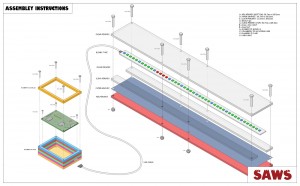| Greg Cope mailed us a few weeks ago with a pointer to this project, which has been monitoring DevOps at the Financial Times (FT) here in the UK.
It’s hard for everyone in the group to simultaneously maintain an overview of the health of the stack under normal circumstances. They use Nagios, a great piece of kit with one fatal flaw: Nagios emails everybody on the team every time a check changes state. Checks change state all the time, and that many emails causes the FT team to enter a state where absolutely none of them reads emails from Nagios, because they clog up their inboxes. Silvano Dossan, who works on the team, says:
The team rejected shared office displays in the form of monitors (too much text, too hard to read from a distance). They also rejected a particularly horrible idea whereby a single team member would be allotted the task of staying alert and monitoring all Nagios’ mails for the week, feeding back news of any disasters to the rest of the group. Sounds horrific. Silvano sat back to think about exactly what they needed and didn’t need from alerts.
Rejecting the mongoose idea, Silvano bought a strip of something called Blinkytape (having looked at their website I’m off to buy one myself when I’m done writing this): a flexible strip of 60 RGB LEDs, with a microcontroller already embedded in the strip. Using a Raspberry Pi and a lot of glue and sticky tape, he produced a perfectly simple, unmissable display to demonstrate the health of the stack.
Silvano says:
It’s an ingenious solution: and it works. There can’t be a cleaner stack in the country, now SAWS is in place, and the team have been incredibly enthusiastic about the change. You can read more about it over at Engine Room the FT’s tech blog; and Silvano has made all the code available at GitHub. |
A Semi-automated Technology Roundup Provided by Linebaugh Public Library IT Staff | techblog.linebaugh.org
Wednesday, July 2, 2014
The big flashing DevOps thing
Subscribe to:
Post Comments (Atom)




No comments:
Post a Comment